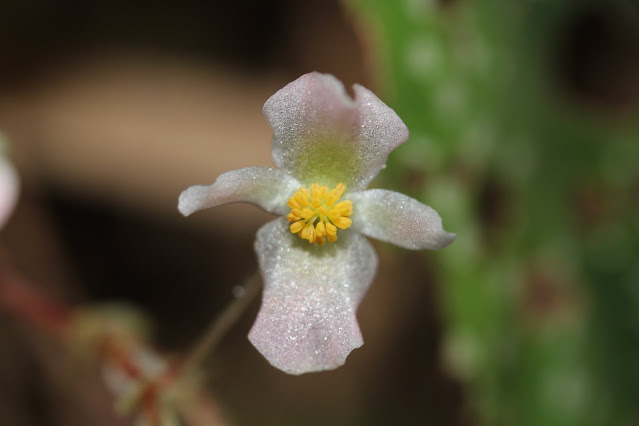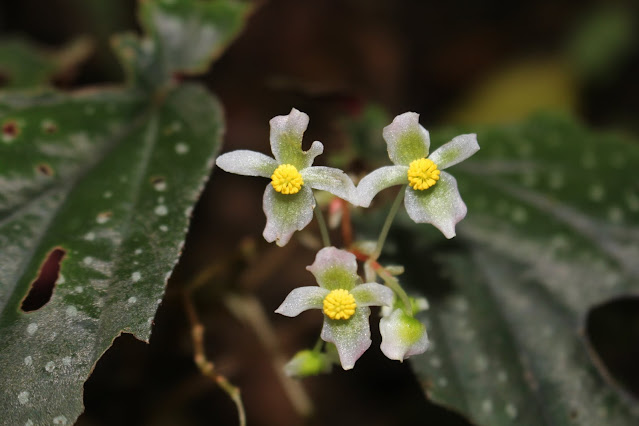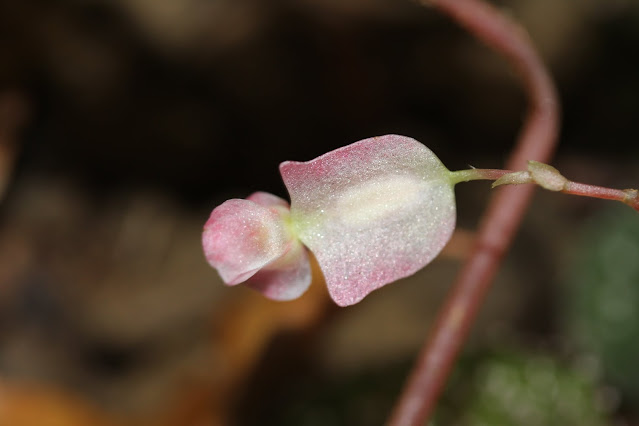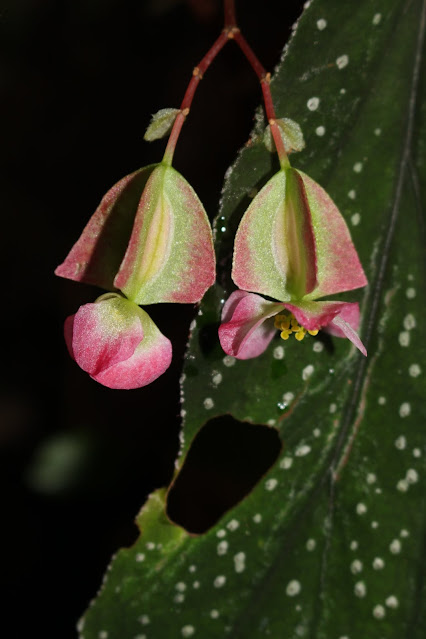Begonia lecongkietii N.S.Lý & M.Hughes, Edinburgh J. Bot. 75(2): 168 (2018).
 |
| Begonia lecongkietii N.S.Lý & M.Hughes, Photo by Hoang Thanh Son |
its native range is Vietnam.
Latin name:
Begonia lecongkietii N.S.Lý & M.Hughes
Family:
Begoniaceae C.Agardh
Synonyms:
No synonyms are recorded for this name.
Vietnamese name:
Thu hải đường lê công kiệt.
Etymology.
Named in honour of Professor Lê Công Kiệt, University of Science, Vietnam National University, Ho Chi Minh City, for his long-time contribution to Vietnamese botany.
Describtion:
Perennial, erect caulescent herb to 85 cm tall. Stem slightly woody, glabrescent, internodes (1–)1.5–5(–8) cm long, slightly swollen at nodes, young stem dull greenpurple to red-purple with somewhat strigose hairs, becoming greyish and glabrescent. Stipules narrowly ovate-lanceolate, 1.2–1.6 cm long, 2.6–3.5 mm at widest point, opaque greenish or green-reddish, outer surface with strigose hairs, inner surface glabrous, with a shortly filiform extension at the tip 2–3 mm long, caducous. Leaves alternate; petiole 2–6.3 cm long, red-purple, with rather short strigose hairs; lamina basifixed, 12–24.5 × 4.5–9.5 cm, asymmetrical, somewhat elliptic-lanceolate, thin and chartaceous when dry, base cordate with somewhat overlapping lobes, apex long acuminate, margin irregularly dentate, venation palmate-pinnate, adaxially dark green with fleshy bristles scattered midway between the veins, abaxially maroon or greenmaroon, with short fleshy strigose hairs spaced along the veins and minute white bristles scattered between the veins. Inflorescence bisexual, axillary and/or terminal; dichasial cymes, peduncle 20–25 mm long, c.1.5 mm wide, purple, densely villose; 2–5 branches, 5–40 mm long, usually 2 female flowers at base and 2–5 male flowers distally, protogynous; bracts semipersistent, membranous, suborbicular, 5–7 mm long, 4.5– 6 mm wide, opaque whitish and rusty brown when aged, with a few strigose hairs on midvein of outer surface, inner surface glabrous, apex attenuate, margin dentate. Male flowers on 12–19 mm long, 0.4–0.6 mm thick pedicels, red-purple or greenish, villose; tepals 4: two outer tepals suborbicular, 13.5–18 × 11–14.5 mm, outer surface greenish, densely villose from base to three-quarters of tepal, white-pinkish tinge and glabrous in upper third, inner surface paler and glabrous, margin entire, undulate, slightly curved outwards; two inner tepals obovate to oblanceolate, 10–14 × 3.5–5 mm, paler than outer ones, with a few villose hairs at basal third of outer surface, margin somewhat straightened and shallowly crenate; androecium actinomorphic, with 86–116 stamens in a dense capitulum, subglobose, 5–7 mm in diameter, bright yellow, stamen 2–3 mm long; filaments 1–1.2 mm long, fused into a short central column; anther obovate, 0.9–1.2 mm long, dehiscing by longitudinal slits, c.0.5 mm long, connective not extended, apex slightly retuse. Female flowers on 19–21 mm long, 0.8–1 mm thick pedicels, angled obliquely downwards, red-purple or greenish, villose; ovary trilocular, obovoid, (15–) 22–28 mm long, (14–)20–26 mm at apex including wings, light greenish or pale reddish green, glabrous, wings 3, subequal, 11–15 mm wide, margin with a few strigose hairs; placentas 2 per locule; tepals 5, unequal, outer two suborbicular, 7–7.5 × 7 mm, inner three broadly obovate, c.7 mm long, c.6 mm at widest point, outer surface white or tinged greenish white and villose in basal half, distally tinged white pinkish and glabrous, inner surface paler and glabrous, margin entire, undulate; styles 3, 2–2.5 mm long, shortly fused at base c.0.5 mm long, broadening and flattened towards the apex, yellow-greenish, distally yellow; stigma densely setose-papillose, linear-cristate, lateral sides expanded into short helicoid band. Infructescence to 5 cm long; fruit pendent, on 8–12 mm pedicels, mature capsule 2.8–3.2 × 1.2–2.2 cm, wings equal and rounded at base, truncate at apex. Seeds ellipsoid, 0.2–0.3 mm long, light brown.
Distribution:
Quảng Ngãi Province in the South Central Coast Region, Vietnam.
Ecological:
Begonia lecongkietii is endemic to Quảng Ngãi Province in the South Central Coast Region, Vietnam. It is known only from the type locality, Mount Dầu, in habitats such as stream banks, on shaded steep slopes in secondary evergreen broadleaved forest dominated by dipterocarps and associated with recently described endemic taxa such as Newmania orthostachys N.S.Lý & Škornick. and ˇ Newmania serpens N.S.Lý & Škornick. (Leong-Škorni ˇ cková ˇ et al., 2011), Zingiber skornickovae N.S.Lý (Lý, 2016), Aspidistra averyanovii N.S.Lý & Tillich (Lý & Tillich, 2016) and Alpinia newmanii N.S.Lý (Lý, 2017), at elevation c.100–490 m.
Flower times:
Phenology. Flowering from April to May and fruiting from late May to June or July.
Type:
Collector Team:
Ngoc-Sâm Lý Lý 608
Locality:
Quảng Ngãi Province, Nghĩa Hành District, Hành Tín Đông Commune, Khánh Giang Village, Đá Bàn Hill, 489 m
Collection Date:
11 Apr 2015
Type Herbaria:
holotype VNM
isotype E
isotype P
Latitude:
14° 54' N
Longitude:
108° 48' E
Distribution Of Types:
Vietnam (Indo-China, Asia-Tropical)
Pharmacology:
Uses:
References:
https://www.ipni.org/n/77186959-1
http://powo.science.kew.org/taxon/urn:lsid:ipni.org:names:77186959-1
Lý, N. et al. “BEGONIA LECONGKIETII (SECT. PETERMANNIA ), A NEW SPECIES FROM MOUNT DẦU, SOUTH CENTRAL COAST REGION, VIETNAM.” Edinburgh Journal of Botany 75 (2018): 167-172.






0 Comment:
Post a Comment